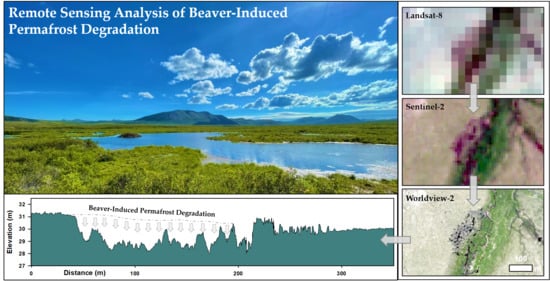Multi-Dimensional Remote Sensing Analysis Documents Beaver-Induced Permafrost Degradation, Seward Peninsula, Alaska
Abstract
:1. Introduction
2. Materials and Methods
2.1. Study Area
2.2. Remote Sensing Observational Datasets
2.2.1. Multi-Resolution Optical Image Observations
2.2.2. Reconstructing Beaver Activity
2.2.3. Measuring Topographic Change
2.2.4. Multispectral Indices
2.2.5. UAS Data Collection
2.2.6. Summer Precipitation Data
3. Results
3.1. Timing of Beaver Activities
3.2. Fluvial Geomorphology
3.3. Changes in Vegetation and Snow
4. Discussion
5. Conclusions
Author Contributions
Funding
Institutional Review Board Statement
Informed Consent Statement
Data Availability Statement
Conflicts of Interest
References
- Graham, R.M.; Cohen, L.; Petty, A.A.; Boisvert, L.N.; Rinke, A.; Hudson, S.R.; Nicolaus, M.; Granskog, M.A. Increasing Frequency and Duration of Arctic Winter Warming Events. Geophys. Res. Lett. 2017, 44, 6974–6983. [Google Scholar] [CrossRef] [Green Version]
- Landrum, L.; Holland, M.M. Extremes Become Routine in an Emerging New Arctic. Nat. Clim. Chang. 2020, 10, 1108–1115. [Google Scholar] [CrossRef]
- Bintanja, R.; Andry, O. Towards a Rain-Dominated Arctic. Nat. Clim. Chang. 2017, 7, 263–267. [Google Scholar] [CrossRef]
- Bintanja, R. The Impact of Arctic Warming on Increased Rainfall. Sci. Rep. 2018, 8, 16001. [Google Scholar] [CrossRef] [PubMed] [Green Version]
- Box, J.E.; Colgan, W.T.; Christensen, T.R.; Schmidt, N.M.; Lund, M.; Parmentier, F.-J.W.; Brown, R.; Bhatt, U.S.; Euskirchen, E.S.; Romanovsky, V.E.; et al. Key Indicators of Arctic Climate Change: 1971–2017. Environ. Res. Lett. 2019, 14, 045010. [Google Scholar] [CrossRef]
- Jenkins, M.; Dai, A. The Impact of Sea-Ice Loss on Arctic Climate Feedbacks and Their Role for Arctic Amplification. Geophys. Res. Lett. 2021, 48, e2021GL094599. [Google Scholar] [CrossRef]
- Lawrence, D.M.; Slater, A.G.; Tomas, R.A.; Holland, M.M.; Deser, C. Accelerated Arctic Land Warming and Permafrost Degradation during Rapid Sea Ice Loss. Geophys. Res. Lett. 2008, 35. [Google Scholar] [CrossRef] [Green Version]
- Biskaborn, B.K.; Smith, S.L.; Noetzli, J.; Matthes, H.; Vieira, G.; Streletskiy, D.A.; Schoeneich, P.; Romanovsky, V.E.; Lewkowicz, A.G.; Abramov, A.; et al. Permafrost Is Warming at a Global Scale. Nat. Commun. 2019, 10, 264. [Google Scholar] [CrossRef] [PubMed] [Green Version]
- Berner, L.T.; Massey, R.; Jantz, P.; Forbes, B.C.; Macias-Fauria, M.; Myers-Smith, I.; Kumpula, T.; Gauthier, G.; Andreu-Hayles, L.; Gaglioti, B.V.; et al. Summer Warming Explains Widespread but Not Uniform Greening in the Arctic Tundra Biome. Nat. Commun. 2020, 11, 4621. [Google Scholar] [CrossRef] [PubMed]
- Pearson, R.G.; Phillips, S.J.; Loranty, M.M.; Beck, P.S.A.; Damoulas, T.; Knight, S.J.; Goetz, S.J. Shifts in Arctic Vegetation and Associated Feedbacks under Climate Change. Nat. Clim. Chang. 2013, 3, 673–677. [Google Scholar] [CrossRef]
- Tape, K.; Sturm, M.; Racine, C. The Evidence for Shrub Expansion in Northern Alaska and the Pan-Arctic. Glob. Chang. Biol. 2006, 12, 686–702. [Google Scholar] [CrossRef]
- Myers-Smith, I.H.; Grabowski, M.M.; Thomas, H.J.D.; Angers-Blondin, S.; Daskalova, G.N.; Bjorkman, A.D.; Cunliffe, A.M.; Assmann, J.J.; Boyle, J.S.; McLeod, E.; et al. Eighteen Years of Ecological Monitoring Reveals Multiple Lines of Evidence for Tundra Vegetation Change. Ecol. Monogr. 2019, 89, e01351. [Google Scholar] [CrossRef] [Green Version]
- Wrona, F.J.; Johansson, M.; Culp, J.M.; Jenkins, A.; Mård, J.; Myers-Smith, I.H.; Prowse, T.D.; Vincent, W.F.; Wookey, P.A. Transitions in Arctic Ecosystems: Ecological Implications of a Changing Hydrological Regime. J. Geophys. Res. Biogeosciences 2016, 121, 650–674. [Google Scholar] [CrossRef] [Green Version]
- Lafrenière, M.J.; Lamoureux, S.F. Effects of Changing Permafrost Conditions on Hydrological Processes and Fluvial Fluxes. Earth-Sci. Rev. 2019, 191, 212–223. [Google Scholar] [CrossRef]
- McCarty, J.L.; Aalto, J.; Paunu, V.-V.; Arnold, S.R.; Eckhardt, S.; Klimont, Z.; Fain, J.J.; Evangeliou, N.; Venäläinen, A.; Tchebakova, N.M.; et al. Reviews and Syntheses: Arctic Fire Regimes and Emissions in the 21st Century. Biogeosciences 2021, 18, 5053–5083. [Google Scholar] [CrossRef]
- Wang, J.A.; Sulla-Menashe, D.; Woodcock, C.E.; Sonnentag, O.; Keeling, R.F.; Friedl, M.A. Extensive Land Cover Change across Arctic–Boreal Northwestern North America from Disturbance and Climate Forcing. Glob. Chang. Biol. 2020, 26, 807–822. [Google Scholar] [CrossRef] [PubMed]
- Farquharson, L.M.; Romanovsky, V.E.; Cable, W.L.; Walker, D.A.; Kokelj, S.V.; Nicolsky, D. Climate Change Drives Widespread and Rapid Thermokarst Development in Very Cold Permafrost in the Canadian High Arctic. Geophys. Res. Lett. 2019, 46, 6681–6689. [Google Scholar] [CrossRef] [Green Version]
- Nitze, I.; Cooley, S.W.; Duguay, C.R.; Jones, B.M.; Grosse, G. The Catastrophic Thermokarst Lake Drainage Events of 2018 in Northwestern Alaska: Fast-Forward into the Future. Cryosphere 2020, 14, 4279–4297. [Google Scholar] [CrossRef]
- Ward Jones, M.K.; Pollard, W.H.; Jones, B.M. Rapid Initialization of Retrogressive Thaw Slumps in the Canadian High Arctic and Their Response to Climate and Terrain Factors. Environ. Res. Lett. 2019, 14, 055006. [Google Scholar] [CrossRef]
- Vincent, W.F.; Lemay, M.; Allard, M. Arctic Permafrost Landscapes in Transition: Towards an Integrated Earth System Approach. Arct. Sci. 2017, 3, 39–64. [Google Scholar] [CrossRef] [Green Version]
- Vincent, W.F.; Callaghan, T.V.; Dahl-Jensen, D.; Johansson, M.; Kovacs, K.M.; Michel, C.; Prowse, T.; Reist, J.D.; Sharp, M. Ecological Implications of Changes in the Arctic Cryosphere. AMBIO 2011, 40, 87–99. [Google Scholar] [CrossRef] [Green Version]
- Vonk, J.E.; Tank, S.E.; Bowden, W.B.; Laurion, I.; Vincent, W.F.; Alekseychik, P.; Amyot, M.; Billet, M.F.; Canário, J.; Cory, R.M.; et al. Reviews and Syntheses: Effects of Permafrost Thaw on Arctic Aquatic Ecosystems. Biogeosciences 2015, 12, 7129–7167. [Google Scholar] [CrossRef] [Green Version]
- McGuire, A.D.; Anderson, L.G.; Christensen, T.R.; Dallimore, S.; Guo, L.; Hayes, D.J.; Heimann, M.; Lorenson, T.D.; Macdonald, R.W.; Roulet, N. Sensitivity of the Carbon Cycle in the Arctic to Climate Change. Ecol. Monogr. 2009, 79, 523–555. [Google Scholar] [CrossRef] [Green Version]
- Bruhwiler, L.; Parmentier, F.-J.W.; Crill, P.; Leonard, M.; Palmer, P.I. The Arctic Carbon Cycle and Its Response to Changing Climate. Curr. Clim. Chang. Rep. 2021, 7, 14–34. [Google Scholar] [CrossRef]
- Schuur, E.A.; McGuire, A.D.; Schädel, C.; Grosse, G.; Harden, J.W.; Hayes, D.J.; Hugelius, G.; Koven, C.D.; Kuhry, P.; Lawrence, D.M.; et al. Climate Change and the Permafrost Carbon Feedback. Nature 2015, 520, 171–179. [Google Scholar] [CrossRef] [PubMed]
- Hjort, J.; Karjalainen, O.; Aalto, J.; Westermann, S.; Romanovsky, V.E.; Nelson, F.E.; Etzelmüller, B.; Luoto, M. Degrading Permafrost Puts Arctic Infrastructure at Risk by Mid-Century. Nat. Commun. 2018, 9, 5147. [Google Scholar] [CrossRef]
- Schneider von Deimling, T.; Lee, H.; Ingeman-Nielsen, T.; Westermann, S.; Romanovsky, V.; Lamoureux, S.; Walker, D.A.; Chadburn, S.; Trochim, E.; Cai, L.; et al. Consequences of Permafrost Degradation for Arctic Infrastructure – Bridging the Model Gap between Regional and Engineering Scales. Cryosphere 2021, 15, 2451–2471. [Google Scholar] [CrossRef]
- O’Neill, H.B.; Burn, C.R.; Allard, M.; Arenson, L.U.; Bunn, M.I.; Connon, R.F.; Kokelj, S.A.; Kokelj, S.V.; LeBlanc, A.-M.; Morse, P.D.; et al. Permafrost Thaw and Northern Development. Nat. Clim. Chang. 2020, 10, 722–723. [Google Scholar] [CrossRef]
- Christie, K.S.; Hollmen, T.E.; Huntington, H.P.; Lovvorn, J.R. Structured Decision Analysis Informed by Traditional Ecological Knowledge as a Tool to Strengthen Subsistence Systems in a Changing Arctic. Ecol. Soc. 2018, 23, 42. [Google Scholar] [CrossRef] [Green Version]
- Herman-Mercer, N.M.; Laituri, M.; Massey, M.; Matkin, E.; Toohey, R.C.; Elder, K.; Schuster, P.F.; Mutter, E. Vulnerability of Subsistence Systems Due to Social and Environmental: A Case Study in the Yukon-Kuskokwim Delta, Alaska. Arctic 2019, 72, 258–272. [Google Scholar] [CrossRef]
- Huntington, H.P.; Raymond-Yakoubian, J.; Noongwook, G.; Naylor, N.; Harris, C.; Harcharek, Q.; Adams, B. “We Never Get Stuck”: A Collaborative Analysis of Change and Coastal Community Subsistence Practices in the Northern Bering and Chukchi Seas, Alaska. ARCTIC 2021, 74, 113–126. [Google Scholar] [CrossRef]
- Hauser, D.D.W.; Whiting, A.V.; Mahoney, A.R.; Goodwin, J.; Harris, C.; Schaeffer, R.J.; Schaeffer, R.; Laxague, N.J.M.; Subramaniam, A.; Witte, C.R.; et al. Co-Production of Knowledge Reveals Loss of Indigenous Hunting Opportunities in the Face of Accelerating Arctic Climate Change. Environ. Res. Lett. 2021, 16, 095003. [Google Scholar] [CrossRef]
- Wolken, G.; Anna, L.; Brubaker, M.; Coe, J.A.; Christiansen, H.; Jones, B.M.; Jacquemart, M.; Lovholt, F.; Kaab, A.; Natali, S.; et al. Glacier and Permafrost Hazards. Arct. Rep. Card 2021. [Google Scholar] [CrossRef]
- Brinkman, T.J.; Hansen, W.D.; Chapin, F.S.; Kofinas, G.; BurnSilver, S.; Rupp, T.S. Arctic Communities Perceive Climate Impacts on Access as a Critical Challenge to Availability of Subsistence Resources. Clim. Chang. 2016, 139, 413–427. [Google Scholar] [CrossRef]
- Ford, J.D.; Pearce, T. Climate Change Vulnerability and Adaptation Research Focusing on the Inuit Subsistence Sector in Canada: Directions for Future Research. Can. Geogr. Géographe Can. 2012, 56, 275–287. [Google Scholar] [CrossRef]
- Naylor, A.W.; Ford, J.D.; Pearce, T.; Fawcett, D.; Clark, D.; van Alstine, J. Monitoring the Dynamic Vulnerability of an Arctic Subsistence Food System to Climate Change: The Case of Ulukhaktok, NT. PLoS ONE 2021, 16, e0258048. [Google Scholar] [CrossRef]
- Müller-Schwarze, D. The Beaver: Natural History of a Wetlands Engineer; Cornell University Press: Ithaca, NY, USA, 2011; ISBN 978-0-8014-6086-9. [Google Scholar]
- Bockstoce, J.R. Furs and Frontiers in the Far North: The Contest among Native and Foreign Nations for the Bering Strait Fur Trade; Yale University Press: London, UK, 2009. [Google Scholar]
- Novak, M.; Ministry of Natural Resources, T.; Baker, J.A.; Obbard, M.E.; Malloch, B. Wild Furbearer Management and Conservation in North America; Ontario Trappers Association: Toronto, ON, Canada, 1987. [Google Scholar]
- Rozhkova-Timina, I.O.; Popkov, V.K.; Mitchell, P.J.; Kirpotin, S.N. Beavers as Ecosystem Engineers—A Review of Their Positive and Negative Effects. IOP Conf. Ser. Earth Environ. Sci. 2018, 201, 012015. [Google Scholar] [CrossRef]
- Wohl, E. Legacy Effects of Loss of Beavers in the Continental United States. Environ. Res. Lett. 2021, 16, 025010. [Google Scholar] [CrossRef]
- Stoll, N.-L.; Westbrook, C.J. Beaver Dam Capacity of Canada’s Boreal Plain in Response to Environmental Change. Sci. Rep. 2020, 10, 16800. [Google Scholar] [CrossRef]
- Tape, K.D.; Jones, B.M.; Arp, C.D.; Nitze, I.; Grosse, G. Tundra Be Dammed: Beaver Colonization of the Arctic. Glob. Chang. Biol. 2018, 24, 4478–4488. [Google Scholar] [CrossRef] [Green Version]
- Mcculloch, D.; Hopkins, D. Evidence for an Early Recent Warm Interval in Northwestern Alaska. GSA Bull. 1966, 77, 1089–1108. [Google Scholar] [CrossRef]
- NeotomaDB.Org|Home. Available online: https://www.neotomadb.org/ (accessed on 1 November 2021).
- Tape, K.D.; Clark, J.A.; Jones, B.M. Beaver Pond Locations in Arctic Alaska, 1949 to 2020. Arct. Data Cent. 2021. [Google Scholar] [CrossRef]
- Jones, B.M.; Tape, K.D.; Clark, J.A.; Nitze, I.; Grosse, G.; Disbrow, J. Increase in Beaver Dams Controls Surface Water and Thermokarst Dynamics in an Arctic Tundra Region, Baldwin Peninsula, Northwestern Alaska. Environ. Res. Lett. 2020, 15, 075005. [Google Scholar] [CrossRef]
- Grosse, G.; Jones, B. Remote Sensing Leads to Better Understanding of Polar Regions. Eos 2018, 99. [Google Scholar] [CrossRef]
- Nitze, I.; Grosse, G.; Jones, B.M.; Romanovsky, V.E.; Boike, J. Remote Sensing Quantifies Widespread Abundance of Permafrost Region Disturbances across the Arctic and Subarctic. Nat. Commun. 2018, 9, 5423. [Google Scholar] [CrossRef] [PubMed]
- Kokelj, S.V.; Jorgenson, M.T. Advances in Thermokarst Research. Permafr. Periglac. Process. 2013, 24, 108–119. [Google Scholar] [CrossRef]
- Rowland, J.C.; Jones, C.E.; Altmann, G.; Bryan, R.; Crosby, B.T.; Hinzman, L.D.; Kane, D.L.; Lawrence, D.M.; Mancino, A.; Marsh, P.; et al. Arctic Landscapes in Transition: Responses to Thawing Permafrost. Eos Trans. Am. Geophys. Union 2010, 91, 229–230. [Google Scholar] [CrossRef]
- National Research Council. Opportunities to Use Remote Sensing in Understanding Permafrost and Related Ecological Characteristics: Report of a Workshop; National Academies Press: Washington, DC, USA, 2014; ISBN 978-0-309-30124-4. [Google Scholar]
- Boike, J.; Nitzbon, J.; Anders, K.; Grigoriev, M.; Bolshiyanov, D.; Langer, M.; Lange, S.; Bornemann, N.; Morgenstern, A.; Schreiber, P.; et al. A 16-Year Record (2002–2017) of Permafrost, Active-Layer, and Meteorological Conditions at the Samoylov Island Arctic Permafrost Research Site, Lena River Delta, Northern Siberia: An Opportunity to Validate Remote-Sensing Data and Land Surface, Snow, and Permafrost Models. Earth Syst. Sci. Data 2019, 11, 261–299. [Google Scholar] [CrossRef] [Green Version]
- Trofaier, A.M.; Westermann, S.; Bartsch, A. Progress in Space-Borne Studies of Permafrost for Climate Science: Towards a Multi-ECV Approach. Remote Sens. Environ. 2017, 203, 55–70. [Google Scholar] [CrossRef]
- Jones, B.M.; Grosse, G.; Arp, C.D.; Miller, E.; Liu, L.; Hayes, D.J.; Larsen, C.F. Recent Arctic Tundra Fire Initiates Widespread Thermokarst Development. Sci. Rep. 2015, 5, 15865. [Google Scholar] [CrossRef] [PubMed] [Green Version]
- Van der Sluijs, J.; Kokelj, S.V.; Fraser, R.H.; Tunnicliffe, J.; Lacelle, D. Permafrost Terrain Dynamics and Infrastructure Impacts Revealed by UAV Photogrammetry and Thermal Imaging. Remote Sens. 2018, 10, 1734. [Google Scholar] [CrossRef] [Green Version]
- Daly, C.; Smith, J.; Halbleib, M. 1981–2010 High-Resolution Temperature and Precipitation Maps for Alaska Final Report. PRISM Climate Group, Oregon State University: Corvallis, OR, USA, 2018. [Google Scholar]
- Walker, D.A.; Raynolds, M.K.; Daniëls, F.J.A.; Einarsson, E.; Elvebakk, A.; Gould, W.A.; Katenin, A.E.; Kholod, S.S.; Markon, C.J.; Melnikov, E.S.; et al. The Circumpolar Arctic Vegetation Map. J. Veg. Sci. 2005, 16, 267–282. [Google Scholar] [CrossRef]
- Lloyd, A.H.; Rupp, T.S.; Fastie, C.L.; Starfield, A.M. Patterns and Dynamics of Treeline Advance on the Seward Peninsula, Alaska. J. Geophys. Res. Atmos. 2002, 107, ALT 2-1–ALT 2-15. [Google Scholar] [CrossRef] [Green Version]
- Jorgenson, M.; Yoshikawa, K.; Kanevskiy, M.; Shur, Y.; Romanovsky, V.; Marchenko, S.; Jones, B. Permafrost Characteristics of Alaska + Map; University of Alaska: Fairbanks, AK, USA, 2008. [Google Scholar]
- Olefeldt, D.; Goswami, S.; Grosse, G.; Hayes, D.; Hugelius, G.; Kuhry, P.; McGuire, A.D.; Romanovsky, V.E.; Sannel, A.B.K.; Schuur, E.A.G.; et al. Circumpolar Distribution and Carbon Storage of Thermokarst Landscapes. Nat. Commun. 2016, 7, 13043. [Google Scholar] [CrossRef] [PubMed] [Green Version]
- Jones, B.M.; Tape, K.D.; Clark, J.A.; Bondurant, A.C.; Ward Jones, M.K.; Gaglioti, B.V.; Elder, C.D.; Witharana, C.; Miller, C.E. Swan Lake Creek Study Reach Datasets—Beaver Dams, Flowlines, and UAS Imagery; Seward Peninsula, Alaska; 2006–2021. Arct. Data Cent. 2021. [Google Scholar] [CrossRef]
- Porter, C.; Morin, P.; Howat, I.; Noh, M.-J.; Bates, B.; Peterman, K.; Keesey, S.; Schlenk, M.; Gardiner, J.; Tomko, K.; et al. ArcticDEM 2018. Available online: https://www.jstor.org/stable/resrep23563.1?seq=1#metadata_info_tab_contents (accessed on 2 November 2021).
- Hall, D.K.; Riggs, G.A.; Salomonson, V.V. Development of Methods for Mapping Global Snow Cover Using Moderate Resolution Imaging Spectroradiometer Data. Remote Sens. Environ. 1995, 54, 127–140. [Google Scholar] [CrossRef]
- Pettorelli, N.; Vik, J.O.; Mysterud, A.; Gaillard, J.-M.; Tucker, C.J.; Stenseth, N.C. Using the Satellite-Derived NDVI to Assess Ecological Responses to Environmental Change. Trends Ecol. Evol. 2005, 20, 503–510. [Google Scholar] [CrossRef]
- Sentinel Hub. Available online: https://www.sentinel-hub.com/ (accessed on 26 October 2021).
- Climate Data Online (CDO). The National Climatic Data Center’s (NCDC) Climate Data Online (CDO) Provides Free Access to NCDC’s Archive of Historical Weather and Climate Data in Addition to Station History Information. | National Climatic Data Center (NCDC). Available online: https://www.ncdc.noaa.gov/cdo-web/ (accessed on 2 November 2021).
- Christensen, T.R.; Lund, M.; Skov, K.; Abermann, J.; López-Blanco, E.; Scheller, J.; Scheel, M.; Jackowicz-Korczynski, M.; Langley, K.; Murphy, M.J.; et al. Multiple Ecosystem Effects of Extreme Weather Events in the Arctic. Ecosystems 2021, 24, 122–136. [Google Scholar] [CrossRef]
- Kuhn, C.; Butman, D. Declining Greenness in Arctic-Boreal Lakes. Proc. Natl. Acad. Sci. USA 2021, 118, e2021219118. [Google Scholar] [CrossRef]
- Arp, C.D.; Whitman, M.S.; Kemnitz, R.; Stuefer, S.L. Evidence of Hydrological Intensification and Regime Change From Northern Alaskan Watershed Runoff. Geophys. Res. Lett. 2020, 47, e2020GL089186. [Google Scholar] [CrossRef]
- Demmer, R.; Beschta, R.L. Recent History (1988–2004) of Beaver Dams along Bridge Creek in Central Oregon. Northwest Sci. 2008, 82, 309–318. [Google Scholar] [CrossRef]
- Butler, D.R.; Malanson, G.P. The Geomorphic Influences of Beaver Dams and Failures of Beaver Dams. Geomorphology 2005, 71, 48–60. [Google Scholar] [CrossRef]
- Larsen, A.; Larsen, J.R.; Lane, S.N. Dam Builders and Their Works: Beaver Influences on the Structure and Function of River Corridor Hydrology, Geomorphology, Biogeochemistry and Ecosystems. Earth-Sci. Rev. 2021, 218, 103623. [Google Scholar] [CrossRef]
- Burchsted, D.; Daniels, M.; Thorson, R.; Vokoun, J. The River Discontinuum: Applying Beaver Modifications to Baseline Conditions for Restoration of Forested Headwaters. BioScience 2010, 60, 908–922. [Google Scholar] [CrossRef] [Green Version]
- Jorgenson, M.T.; Osterkamp, T.E. Response of Boreal Ecosystems to Varying Modes of Permafrost Degradation. Can. J. For. Res. 2005, 35, 2100–2111. [Google Scholar] [CrossRef]
- Jorgenson, M.T. 8.20 Thermokarst Terrains. 2013. Available online: https://www.academia.edu/25248005/Thermokarst_Terrains (accessed on 2 November 2021).
- Fuchs, M.; Nitze, I.; Strauss, J.; Günther, F.; Wetterich, S.; Kizyakov, A.; Fritz, M.; Opel, T.; Grigoriev, M.N.; Maksimov, G.T.; et al. Rapid Fluvio-Thermal Erosion of a Yedoma Permafrost Cliff in the Lena River Delta. Front. Earth Sci. 2020, 8, 336. [Google Scholar] [CrossRef]
- Shur, Y.; Jones, B.M.; Kanevskiy, M.; Jorgenson, T.; Jones, M.K.W.; Fortier, D.; Stephani, E.; Vasiliev, A. Fluvio-Thermal Erosion and Thermal Denudation in the Yedoma Region of Northern Alaska: Revisiting the Itkillik River Exposure. Permafr. Periglac. Process. 2021, 32, 277–298. [Google Scholar] [CrossRef]
- Fortier, D.; Allard, M.; Shur, Y. Observation of Rapid Drainage System Development by Thermal Erosion of Ice Wedges on Bylot Island, Canadian Arctic Archipelago. Permafr. Periglac. Process. 2007, 18, 229–243. [Google Scholar] [CrossRef]
- Godin, E.; Fortier, D. Geomorphology of a Thermo-Erosion Gully, Bylot Island, Nunavut, Canada1This Article Is One of a Series of Papers Published in This CJES Special Issue on the Theme of Fundamental and Applied Research on Permafrost in Canada.2Polar Continental Shelf Project Contribution 043-11. Can. J. Earth Sci. 2012, 49, 979–986. [Google Scholar] [CrossRef]
- Turner, K.W.; Pearce, M.D.; Hughes, D.D. Detailed Characterization and Monitoring of a Retrogressive Thaw Slump from Remotely Piloted Aircraft Systems and Identifying Associated Influence on Carbon and Nitrogen Export. Remote Sens. 2021, 13, 171. [Google Scholar] [CrossRef]
- Park, S.-E. Variations of Microwave Scattering Properties by Seasonal Freeze/Thaw Transition in the Permafrost Active Layer Observed by ALOS PALSAR Polarimetric Data. Remote Sens. 2015, 7, 17135–17148. [Google Scholar] [CrossRef] [Green Version]
- Touzi, R.; Hong, G.; Motohka, T.; Shinichi, S.; De Lisle, D. Investigation of Compact SAR L and C Band Complementarity for Permafrost Characterization In Arctic Regions. In Proceedings of the IGARSS 2019—2019 IEEE International Geoscience and Remote Sensing Symposium, Yokohama, Japan, 28 July–2 August 2019; pp. 4665–4667. [Google Scholar]
- Zwieback, S.; Meyer, F.J. Top-of-Permafrost Ground Ice Indicated by Remotely Sensed Late-Season Subsidence. Cryosphere 2021, 15, 2041–2055. [Google Scholar] [CrossRef]
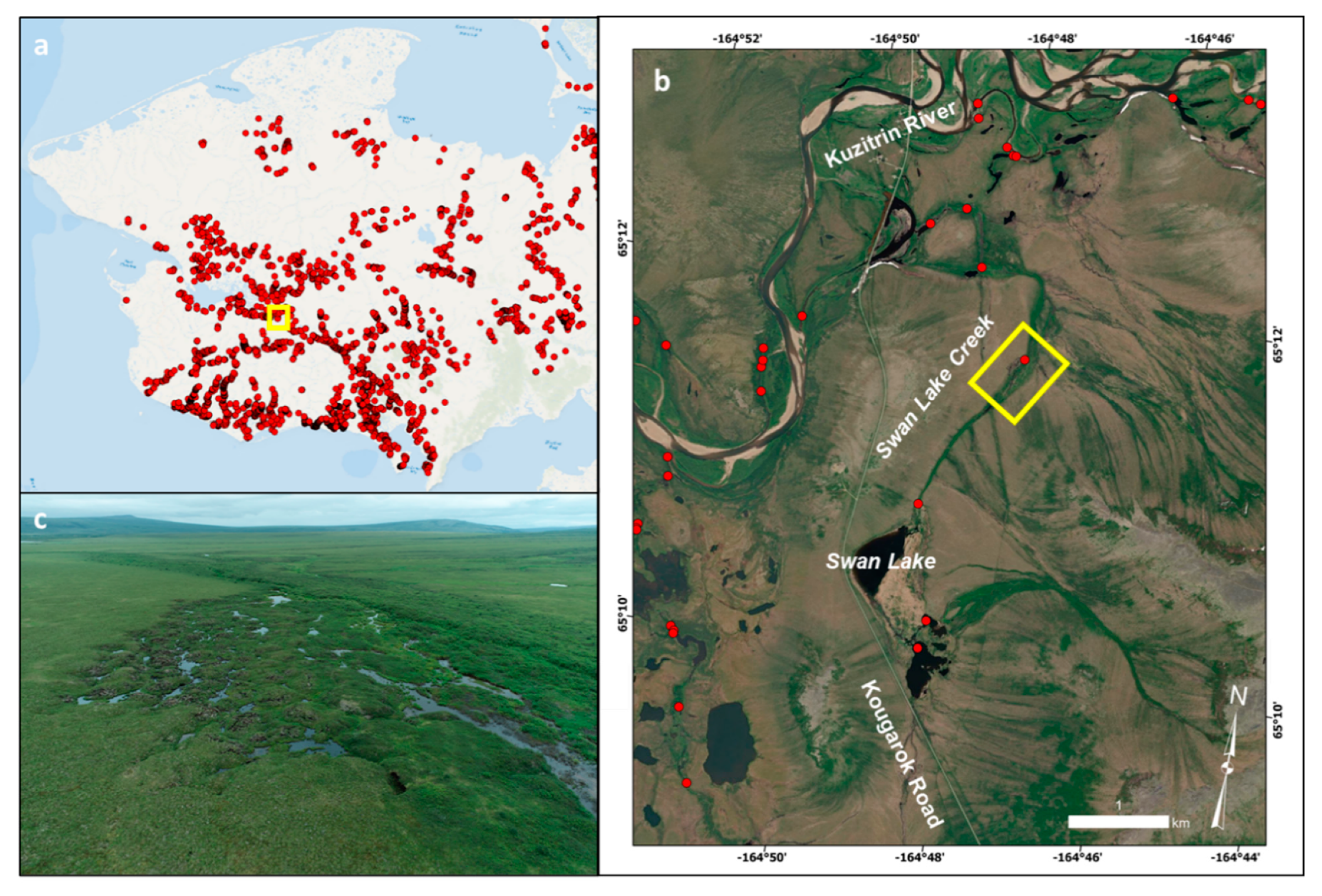
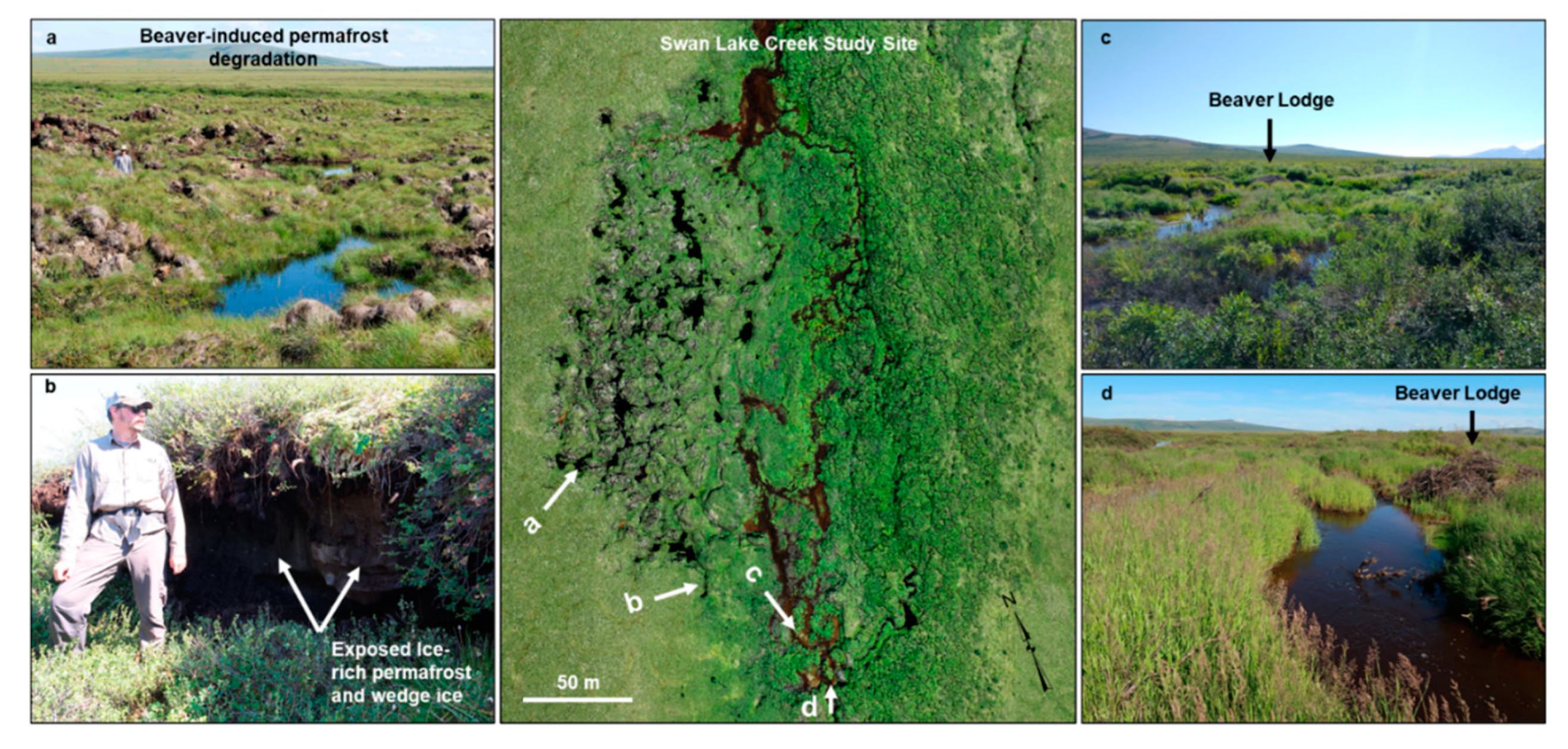
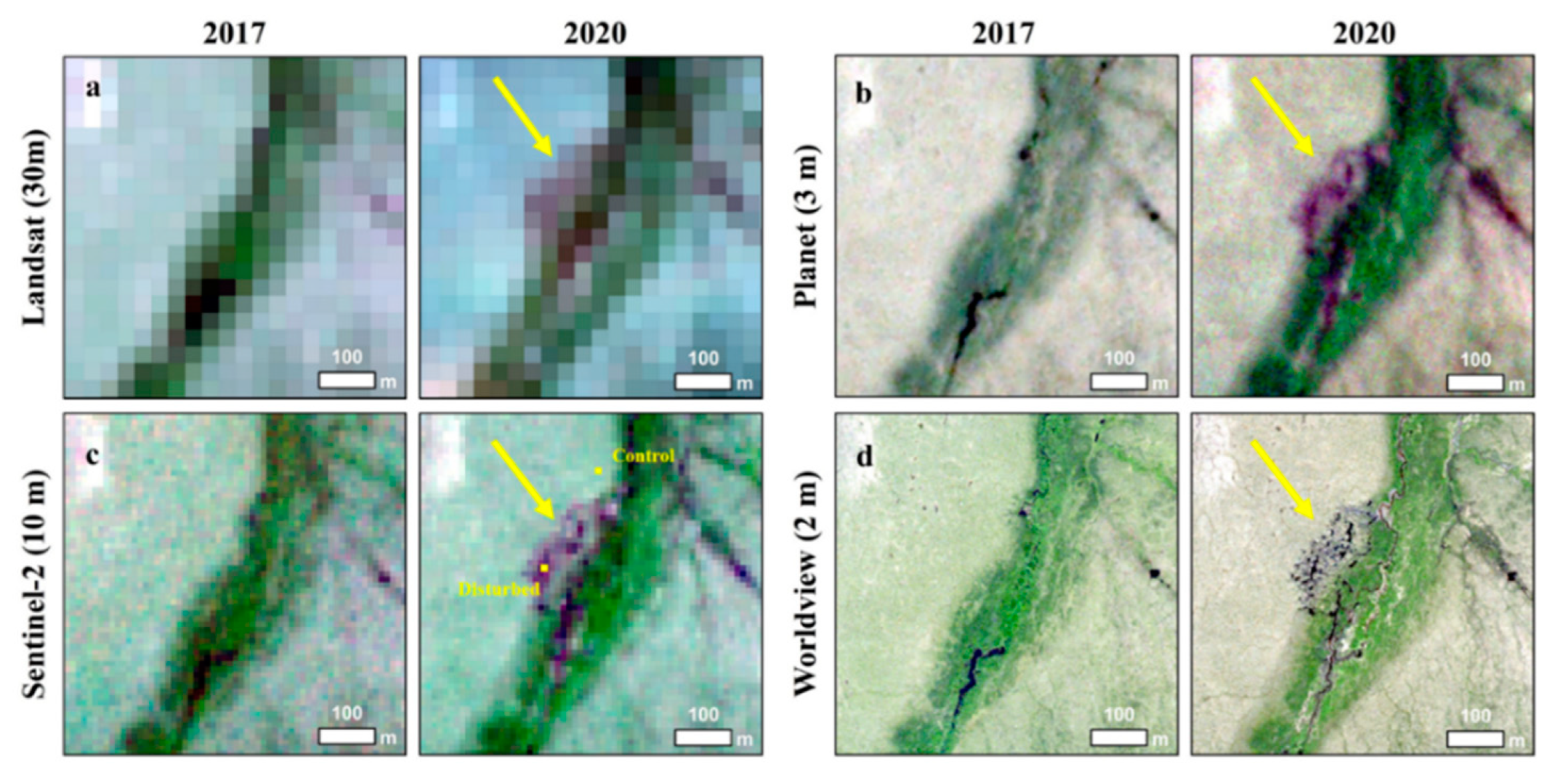
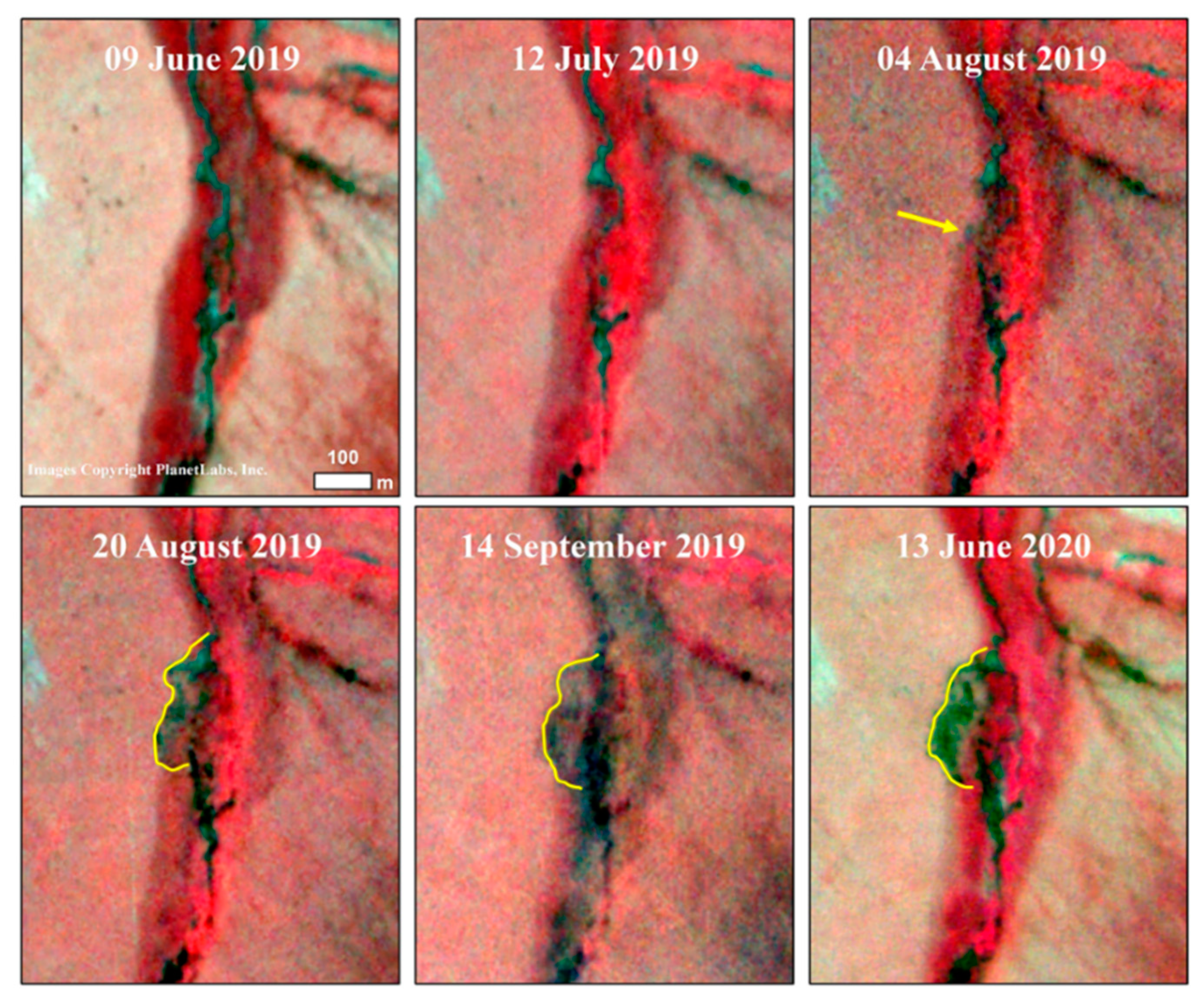

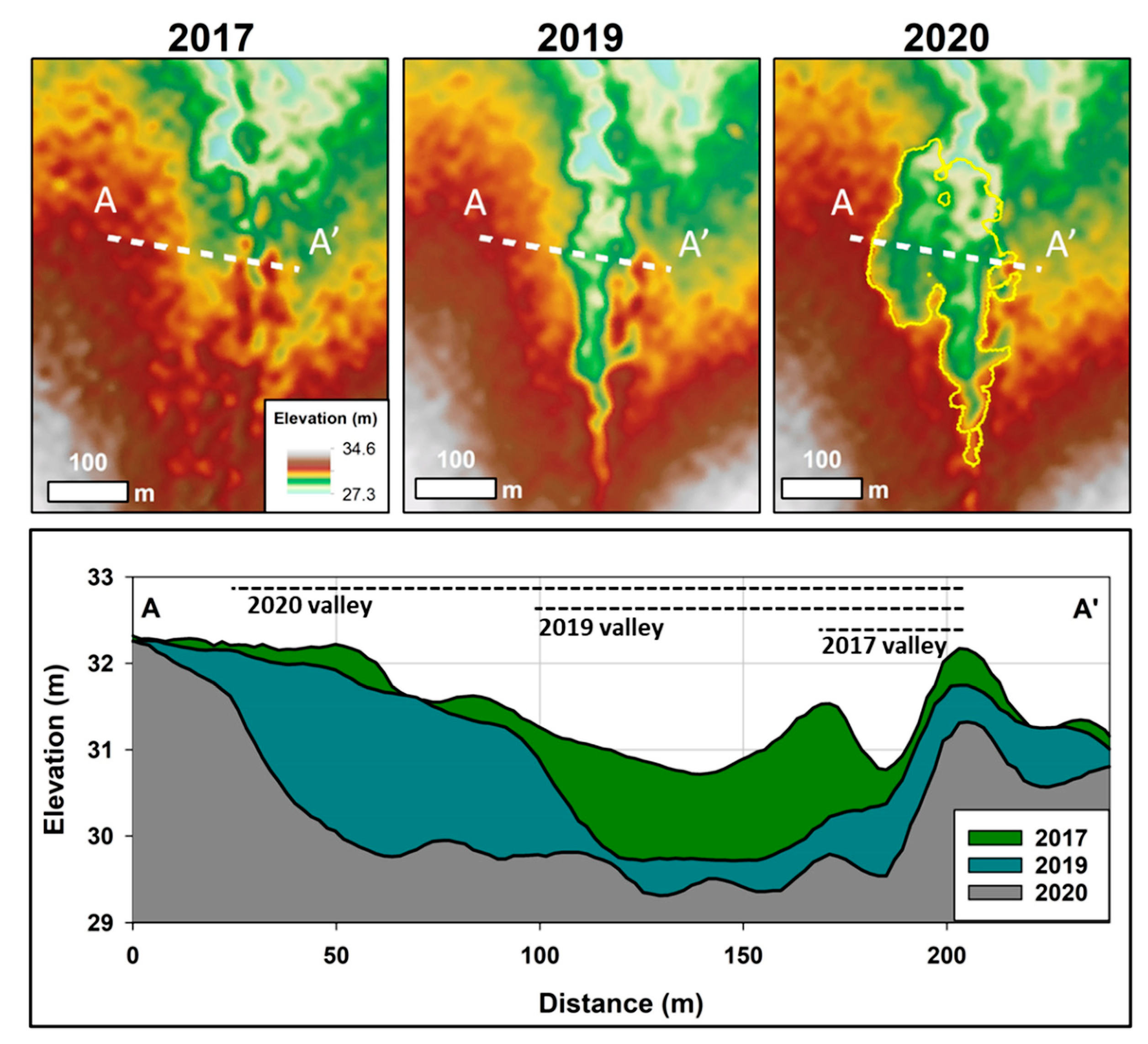




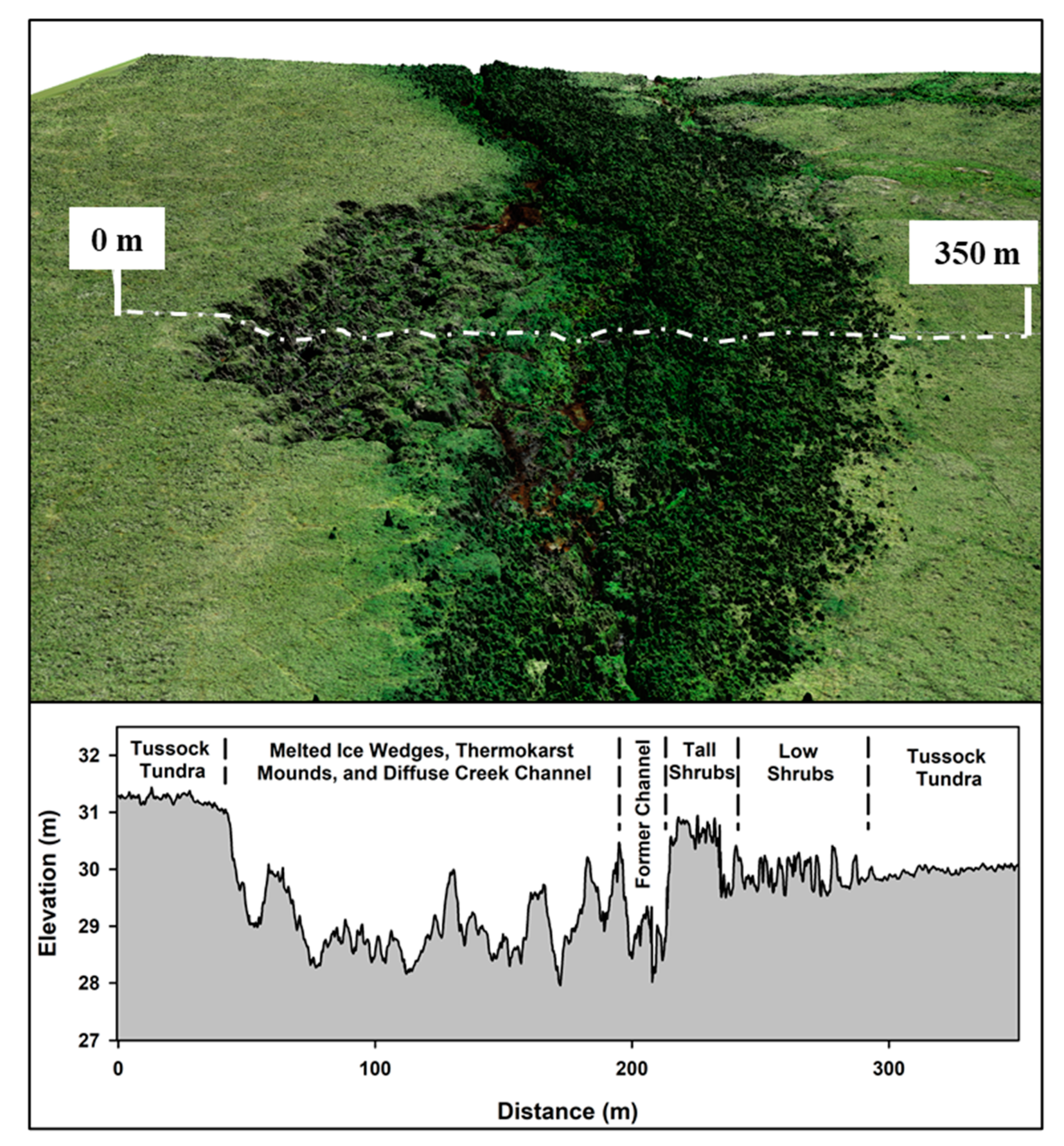
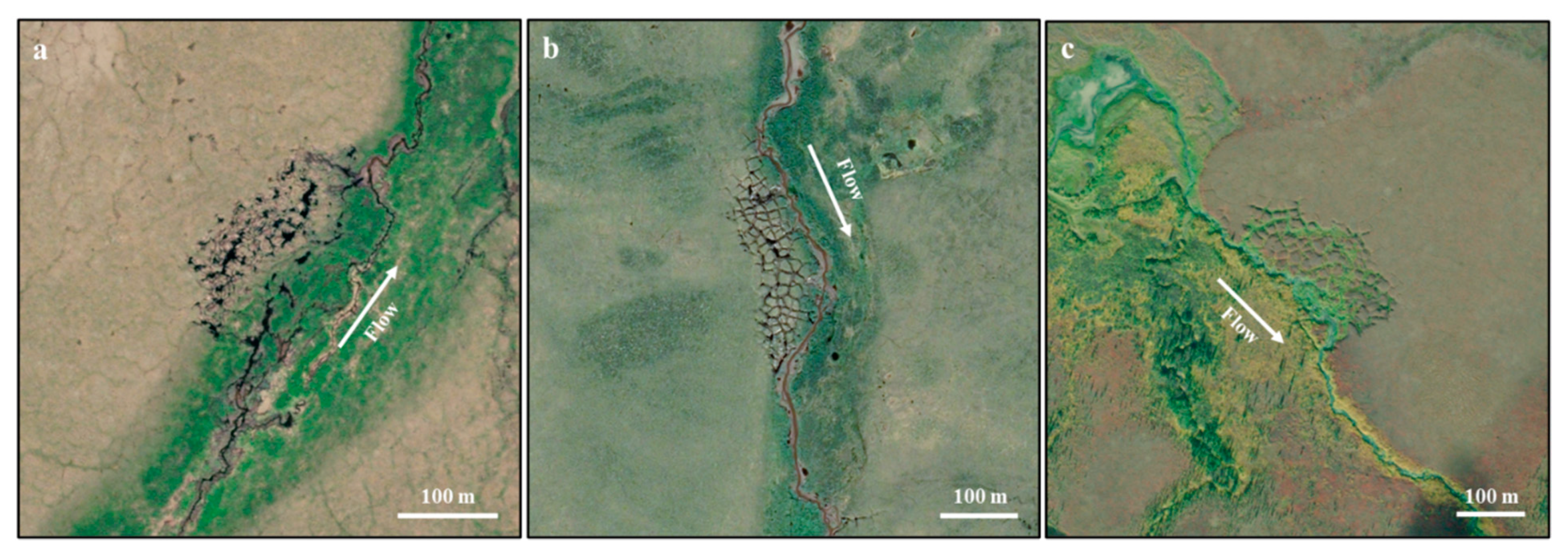
| Image Platform | Spatial Resolution (m) | Temporal Resolution | Spectral Resolution (Bands) | Radiometric Resolution (Bit Depth) | Temporal Range of Images Used | Images in Time Series Analysis (n) | Remote Sensing Application |
|---|---|---|---|---|---|---|---|
| Landsat OLI | 30 | 8–16 days | 8 | 16 | 2017–2021 | 17 | General Observations of Landcover Change |
| Sentinel-2 | 10 | 1–5 days | 4 | 12 | 2017–2021 | 152 | Multi-Spectral Index Trend Analysis |
| PlanetLabs, Inc Cubesats | 3–5 | Daily | 4 | 12 | 2019 (July/August) | 15 | Object Feature Detection Timing |
| Arctic DEM | 2 | Infrequent | N/A | N/A | 2017–2020 | 3 | DSM/dDSM Generation |
| DigitalGlobe, Inc./MAXAR VHRS | 0.5 | Infrequent | 1 | 11 | 2006–2021 | 8 | Object Feature Detection Impacts |
| UAS | 0.15 | Infrequent | 3 | 16 | 2021 | 1 | DSM Generation |
Publisher’s Note: MDPI stays neutral with regard to jurisdictional claims in published maps and institutional affiliations. |
© 2021 by the authors. Licensee MDPI, Basel, Switzerland. This article is an open access article distributed under the terms and conditions of the Creative Commons Attribution (CC BY) license (https://creativecommons.org/licenses/by/4.0/).
Share and Cite
Jones, B.M.; Tape, K.D.; Clark, J.A.; Bondurant, A.C.; Ward Jones, M.K.; Gaglioti, B.V.; Elder, C.D.; Witharana, C.; Miller, C.E. Multi-Dimensional Remote Sensing Analysis Documents Beaver-Induced Permafrost Degradation, Seward Peninsula, Alaska. Remote Sens. 2021, 13, 4863. https://doi.org/10.3390/rs13234863
Jones BM, Tape KD, Clark JA, Bondurant AC, Ward Jones MK, Gaglioti BV, Elder CD, Witharana C, Miller CE. Multi-Dimensional Remote Sensing Analysis Documents Beaver-Induced Permafrost Degradation, Seward Peninsula, Alaska. Remote Sensing. 2021; 13(23):4863. https://doi.org/10.3390/rs13234863
Chicago/Turabian StyleJones, Benjamin M., Ken D. Tape, Jason A. Clark, Allen C. Bondurant, Melissa K. Ward Jones, Benjamin V. Gaglioti, Clayton D. Elder, Chandi Witharana, and Charles E. Miller. 2021. "Multi-Dimensional Remote Sensing Analysis Documents Beaver-Induced Permafrost Degradation, Seward Peninsula, Alaska" Remote Sensing 13, no. 23: 4863. https://doi.org/10.3390/rs13234863
APA StyleJones, B. M., Tape, K. D., Clark, J. A., Bondurant, A. C., Ward Jones, M. K., Gaglioti, B. V., Elder, C. D., Witharana, C., & Miller, C. E. (2021). Multi-Dimensional Remote Sensing Analysis Documents Beaver-Induced Permafrost Degradation, Seward Peninsula, Alaska. Remote Sensing, 13(23), 4863. https://doi.org/10.3390/rs13234863





